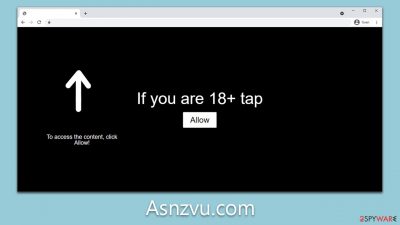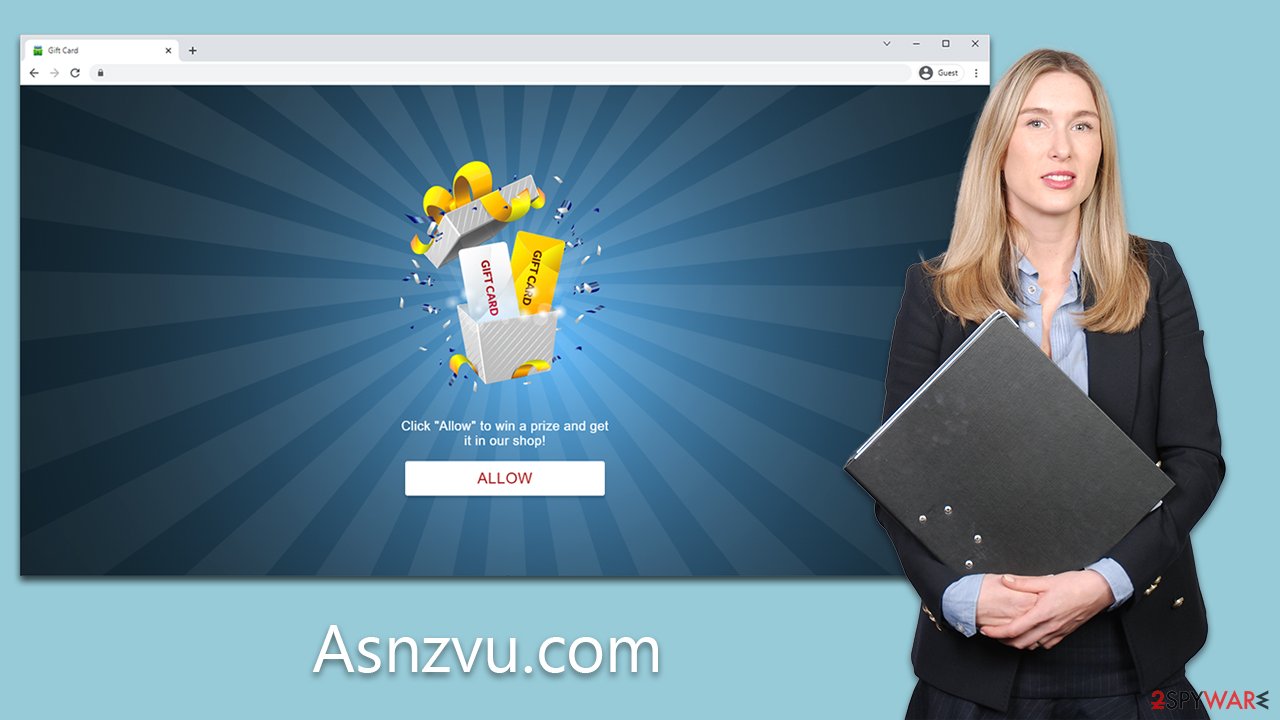Asnzvu.com ads (scam) - Free Guide
Asnzvu.com ads Removal Guide
What is Asnzvu.com ads?
Asnzvu.com shows misleading content to make people subscribe to push notifications

Asnzvu.com is a notorious website known for hosting push notification scams that should never be trusted. Users often encounter this URL when dubious, unsolicited pop-ups labeled with Asnzvu.com appear on their screens while streaming videos, browsing social media, or engaging in unrelated online activities. Although closing the browser may temporarily stop these intrusive pop-ups, it does not address the underlying issue.
Individuals affected by these unwanted pop-ups may have inadvertently agreed to receive push notifications from Asnzvu.com, lured in by the site's deceptive messages. Fortunately, if you find these intrusive ads to be a nuisance, they can be removed without much difficulty – you just need the right guidance. In this article, we will outline the steps necessary to eliminate these annoying pop-ups and offer advice on how to address any adware that may have infiltrated your system.
Remember, it is a malicious website created by scammers, and it is essential to be cautious when encountering unexpected pop-ups or notifications. Protecting your digital privacy and security should always be a top priority.
| Name | Asnzvu.com |
| Type | Push notifications, ads, pop-ups, scam |
| Distribution | Users allow push notifications after they click the “Allow” button within the prompt on the website |
| Symptoms | Push notifications that include misleading information links would show up on the desktop at random times |
| Risks | Push notifications may include incorrect information and links to dangerous websites. If you click the ad, your system might be infected with malware, your identity might be stolen, or you could lose money |
| Termination | Access browser settings to stop intrusive push notifications. After that, make sure that your system is not infected with adware or malware – scan it with SpyHunter 5Combo Cleaner |
| Recovery | It is vital to clean web browser caches to prevent further data tracking and other issues related to web data corruption – use FortectIntego to do this quicker |
Spreading techniques
Scam websites like Asnzvu.com pose a significant threat to users' digital privacy and security. There are several ways people may inadvertently end up on these malicious sites, with two primary causes being clicks on malicious links and redirects on unscrupulous websites, such as torrent sites.
-
Adware infections. Adware is a type of malicious software that displays unwanted ads and pop-ups on a user's device, often redirecting them to scam websites like Asnzvu.com. Users may unknowingly download adware by installing seemingly innocuous software or browser extensions that come bundled with the adware. Once installed, the adware starts generating pop-ups and redirects, leading users to potentially harmful websites. Adware can also monitor users' browsing habits, collecting data that may be used for targeted advertising or even sold to third parties.
-
Redirects on malicious websites. Some websites, particularly those offering free content such as torrent sites, are notorious for hosting redirects to scam websites. Users visiting these sites may click on a download link or even navigate the site's interface, only to be unexpectedly redirected to a malicious site like Asnzvu.com. These redirects can be particularly frustrating as they may occur multiple times during a single browsing session. Additionally, torrent sites often contain adware, which can lead to further unwanted redirects and pop-ups.
To avoid falling victim to scam websites, users should exercise caution when clicking on links and downloading software, particularly from unknown sources. It is also advisable to use reputable security software and keep it updated regularly, as well as avoid visiting potentially malicious websites such as torrent sites.
How scammers trick people
Push notifications are an excellent way to receive timely updates, but cybercriminals have discovered that they can also exploit this feature for their gain by delivering ads and generating revenue. This has led to the creation of malicious websites, such as Asnzvu.com, designed to send phishing messages that trick users into enabling notifications on their browsers.
When users visit Asnzvu.com, they are often confronted with an unexpected prompt featuring “Allow” and “Block” options, accompanied by a misleading message designed to manipulate them into clicking “Allow.” Scammers employ various deceptive tactics to achieve their goals. Here are some examples of messages used in this scam:
- Click Allow to watch the video
- If you are 18+, click Allow
- Click “Allow” to win a prize and get it in our shop!
- Your file is ready to download – press Allow to continue
- Press “Allow” to verify that you are not a robot

It is crucial to recognize that the “Allow” button's functionality, as presented on sites like Asnzvu.com, is counterfeit and should not be trusted. Don't fall for claims that clicking “Allow” will bypass human verification or enable video playback – these are merely scams. To safeguard yourself, promptly close the tab containing the scam and avoid interacting with its contents. By staying vigilant and discerning, you can protect yourself from falling prey to such deceptive push notification scams.
Remove unwanted push notifications easily
Removing unwanted push notifications from malicious websites like Asnzvu.com is an essential step in regaining control over your browsing experience and protecting your digital privacy. To accomplish this, you'll need to delve into your browser settings and manually revoke permission for the offending website to send notifications. While the process might differ slightly across various browsers, the core steps remain similar. Here are the instructions:
Google Chrome (desktop)
- Open the Google Chrome browser and go to Menu > Settings.
- Scroll down and click on Advanced.
- Locate the Privacy and security section and pick Site Settings > Notifications.
- Look at the Allow section and look for a suspicious URL.
- Click the three vertical dots next to it and pick Block. This should remove unwanted notifications from Google Chrome.
![Stop notifications on Chrome PC 2 Stop notifications on Chrome PC 2]()
Google Chrome (Android)
- Open Google Chrome and tap on Settings (three vertical dots).
- Select Notifications.
- Scroll down to the Sites section.
- Locate the unwanted URL and toggle the button to the left (Off setting).
![Stop notifications on Chrome Android Stop notifications on Chrome Android]()
Mozilla Firefox
- Open Mozilla Firefox and go to Menu > Options.
- Click on Privacy & Security section.
- Under Permissions, you should be able to see Notifications. Click the Settings button next to it.
- In the Settings – Notification Permissions window, click on the drop-down menu by the URL in question.
- Select Block and then click on Save Changes. This should remove unwanted notifications from Mozilla Firefox.
![Stop notifications on Mozilla Firefox 2 Stop notifications on Mozilla Firefox 2]()
MS Edge (Chromium)
- Open Microsoft Edge, and go to Settings.
- Select Site permissions.
- Go to Notifications on the right.
- Under Allow, you will find the unwanted entry.
- Click on More actions and select Block.
![Stop notifications on Edge Chromium Stop notifications on Edge Chromium]()
Safari
- Click on Safari > Preferences…
- Go to the Websites tab and, under General, select Notifications.
- Select the web address in question, click the drop-down menu and select Deny.
![Stop notifications on Safari Stop notifications on Safari]()
Internet Explorer
- Open Internet Explorer, and click on the Gear icon at the top-right of the window.
- Select Internet options and go to the Privacy tab.
- In the Pop-up Blocker section, click on Settings.
![Stop notifications on Internet Explorer Stop notifications on Internet Explorer]()
- Locate the web address in question under Allowed sites and pick Remove.
However, it is equally important to ensure that your system is free from adware or other malware that could be causing intrusive notifications. Utilizing reputable security software such as SpyHunter 5Combo Cleaner or Malwarebytes can help you scan for and eliminate any lurking threats. Regularly updating your security software and conducting routine system scans is a best practice to maintain a secure and malware-free environment.
In addition to addressing push notification settings and potential malware infections, it's crucial to clean your browser caches. This process helps eliminate residual tracking data and other remnants left by malicious websites. Tools like FortectIntego can automate this task, effectively cleaning browser caches and addressing any system damage caused by malware.
How to prevent from getting adware
Stream videos without limitations, no matter where you are
There are multiple parties that could find out almost anything about you by checking your online activity. While this is highly unlikely, advertisers and tech companies are constantly tracking you online. The first step to privacy should be a secure browser that focuses on tracker reduction to a minimum.
Even if you employ a secure browser, you will not be able to access websites that are restricted due to local government laws or other reasons. In other words, you may not be able to stream Disney+ or US-based Netflix in some countries. To bypass these restrictions, you can employ a powerful Private Internet Access VPN, which provides dedicated servers for torrenting and streaming, not slowing you down in the process.
Data backups are important – recover your lost files
Ransomware is one of the biggest threats to personal data. Once it is executed on a machine, it launches a sophisticated encryption algorithm that locks all your files, although it does not destroy them. The most common misconception is that anti-malware software can return files to their previous states. This is not true, however, and data remains locked after the malicious payload is deleted.
While regular data backups are the only secure method to recover your files after a ransomware attack, tools such as Data Recovery Pro can also be effective and restore at least some of your lost data.






